child seat Citroen DS3 DAG 2009.5 1.G Owner's Manual
[x] Cancel search | Manufacturer: CITROEN, Model Year: 2009.5, Model line: DS3 DAG, Model: Citroen DS3 DAG 2009.5 1.GPages: 244, PDF Size: 7.12 MB
Page 12 of 244
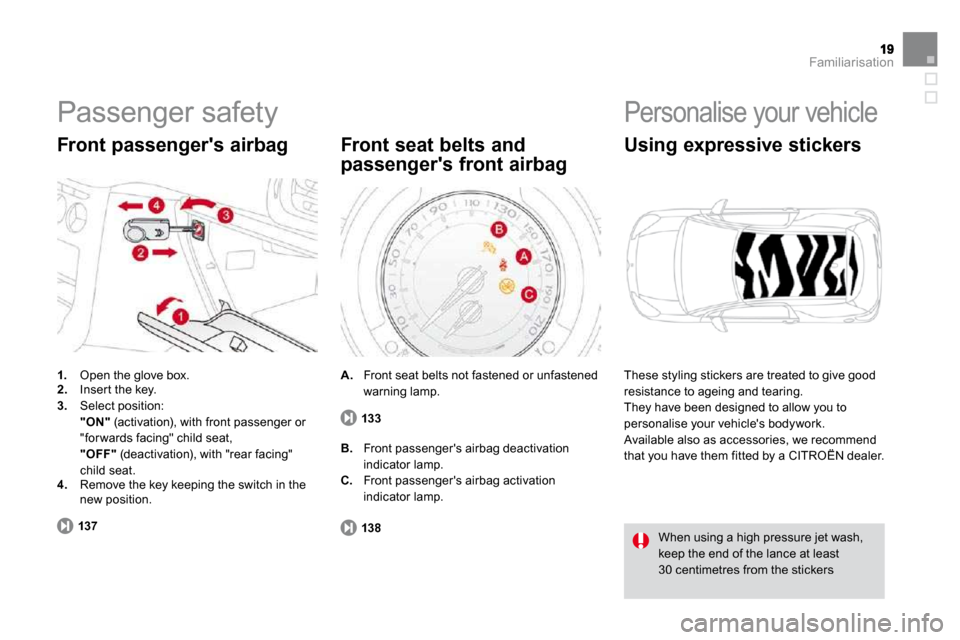
Familiarisation
Passenger safety
1. Open the glove box. 2. Inser t the key. 3. Select position: "ON" (activation), with front passenger or "for wards facing" child seat, "OFF" (deactivation), with "rear facing" child seat. 4. Remove the key keeping the switch in the new position.
Front passenger's airbag
137
A. Front seat belts not fastened or unfastened warning lamp.
Front seat belts and
passenger's front airbag
138
Personalise your vehicle
These styling stickers are treated to give good resistance to ageing and tearing. They have been designed to allow you to personalise your vehicle's bodywork. Available also as accessories, we recommend that you have them fitted by a CITROËN dealer.
Using expressive stickers
When using a high pressure jet wash,
keep the end of the lance at least30 centimetres from the stickers
B. Front passenger's airbag deactivation indicator lamp.
C. Front passenger's airbag activation indicator lamp.
133
Page 18 of 244
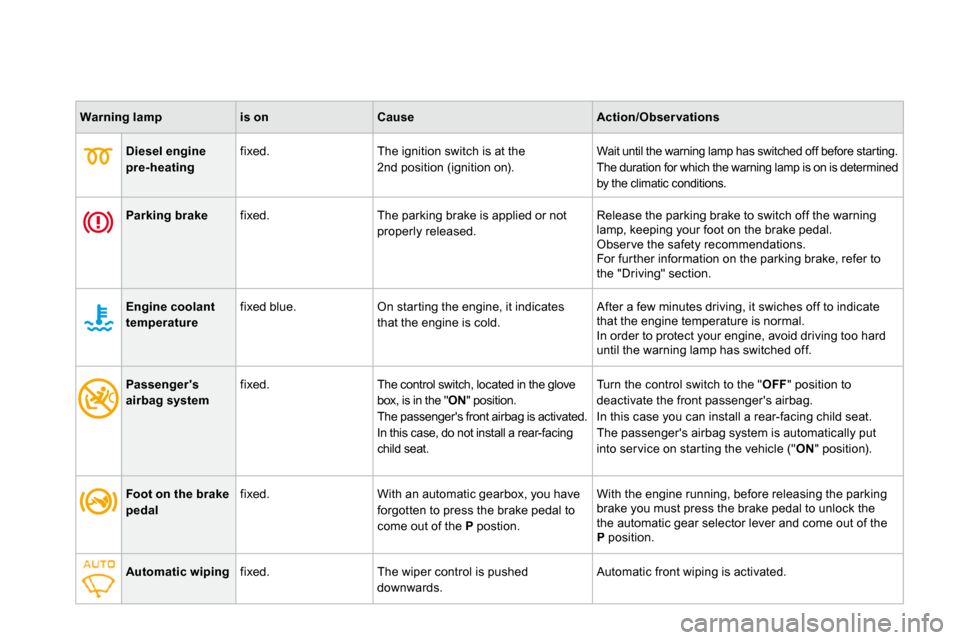
Warning lampis onCauseAction/Obser vations
Diesel engine pre-heating fixed. The ignition switch is at the 2 nd position (ignition on). Wait until the warning lamp has switched off before starting. The duration for which the warning lamp is on is determined by the climatic conditions.
Parking brake fixed. The parking brake is applied or not properly released. Release the parking brake to switch off the warnin g lamp, keeping your foot on the brake pedal. Obser ve the safety recommendations. For fur ther information on the parking brake, refer t o the "Driving" section.
Engine coolant temperature fixed blue. On star ting the engine, it indicates that the engine is cold. After a few minutes driving, it swiches off to indicate that the engine temperature is normal. In order to protect your engine, avoid driving too hard until the warning lamp has switched off.
Foot on the brake pedal fixed. With an automatic gearbox, you have forgotten to press the brake pedal to come out of the P postion.
With the engine running, before releasing the park ing brake you must press the brake pedal to unlock the the automatic gear selector lever and come out of the P position.
Automatic wiping fixed. The wiper control is pushed downwards. Automatic front wiping is activated.
Passenger's airbag system fixed. The control switch, located in the glove box, is in the " ON " position. The passenger's front airbag is activated. In this case, do not install a rear-facing child seat.
Turn the control switch to the " OFF " position to deactivate the front passenger's airbag. In this case you can install a rear-facing child seat. The passenger's airbag system is automatically put into ser vice on star ting the vehicle (" ON " position).
Page 19 of 244

29Instruments and controls
Deactivation indicator lamps
If one of the following indicator lamps comes on, this confirms that the corresponding system has been switch ed off intentionally. This is accompanied by an audible signal and a message on the multifunction screen.
Warning lampis onCauseAction/Obser vations
Passenger's
airbag system
fixed. The control, located in the glove box,
is set to the OFF position. The passenger's front airbag is deactivated. In this case you can install a "rear facing" child seat.
Set the control to the ON position to activate the
passenger's front airbag. In this case, do not fit a child seat in the rear-facing position. The passenger's airbag system is put into ser vice automatically when the vehicle is star ted ( ON position).
ESP/ASR fixed. The button, located at the bottom left of the dashboard, is pressed. Its indicator lamp is on. The ESP/ASR is deactivated. ESP: electronic stability programme. ASR: anti-skid regulation.
Press the button again to manually reactivate the ESP/ASR. Its indicator lamp switches off. From approximately 30 mph (50 km/h), the system is reactivated automatically (except for the 1.6 litre THP 150 engine). The ESP/ASR system is activated automatically when the vehicle is star ted.
Page 110 of 244
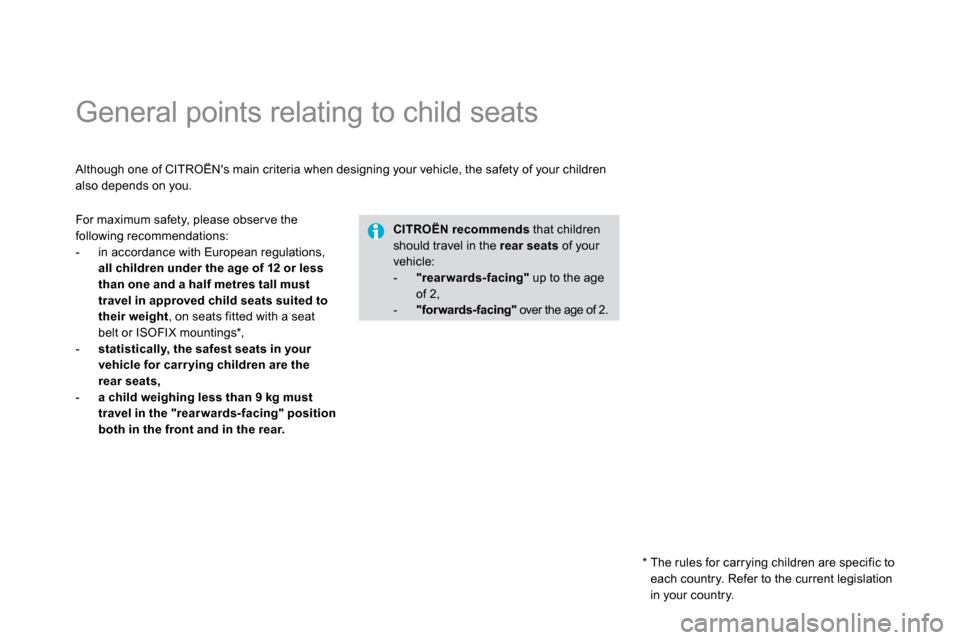
General points relating to child seats
Although one of CITROËN's main criteria when designing your vehicle, the safety of your children also depends on you.
CITROËN recommends that children should travel in the rear seats of your vehicle: - "rear wards-facing" up to the age of 2, - "forwards-facing" over the age of 2.
For maximum safety, please obser ve the following recommendations: - in accordance with European regulations, all children under the age of 12 or less than one and a half metres tall must travel in approved child seats suited to their weight , on seats fitted with a seat belt or ISOFIX mountings * , - statistically, the safest seats in your vehicle for carr ying children are the rear seats, - a child weighing less than 9 kg must travel in the "rear wards-facing" position both in the front and in the rear.
* The rules for carrying children are specific to each country. Refer to the current legislation in your country.
Page 111 of 244

Child safety
Child seat in the front
"Rearwards-facing"
When a "rear wards-facing" child seat is installed on the front passenger seat , it is essential that the passenger airbag is deactivated. Other wise, the child would risk being seriously injured or killed if the airbag were to inflate.
"Forwards-facing"
When a "for wards-facing" child seat is installed on the front passenger seat , adjust the vehicle's seat to the intermediate longitudinal position with the seat back upright and leave the passenger airbag activated.
Intermediate longitudinal position
Page 112 of 244

Passenger air bag OFF
Child seats recommended by CITROËN CITROËN offers a complete range of recommended child seats which are secured using a Child seats recommended by CITROËN Child s
three point seat belt :
Group 0: from bir th to 10 kg Group 0+: from bir th to 13 kgGroups 1, 2 and 3: from 9 to 36 kg
L1 "RÖMER Baby-Safe Plus" Installed in the rear wards-facing position.
L2 "KIDDY Life" The use of the restraining cushion is compulsory for carrying young children (from 9 to 18 kg).
Groups 2 and 3: from 15 to 36 kg
L3 "RECARO Star t''
L4 "KLIPPAN Optima" From the age of 6 years (approximately 22 kg), the booster is used on its own.
L5 "RÖMER KIDFIX" Can be fitted to the vehicle's ISOFIX anchorages. The child is restrained by the seat belt.
Page 113 of 244
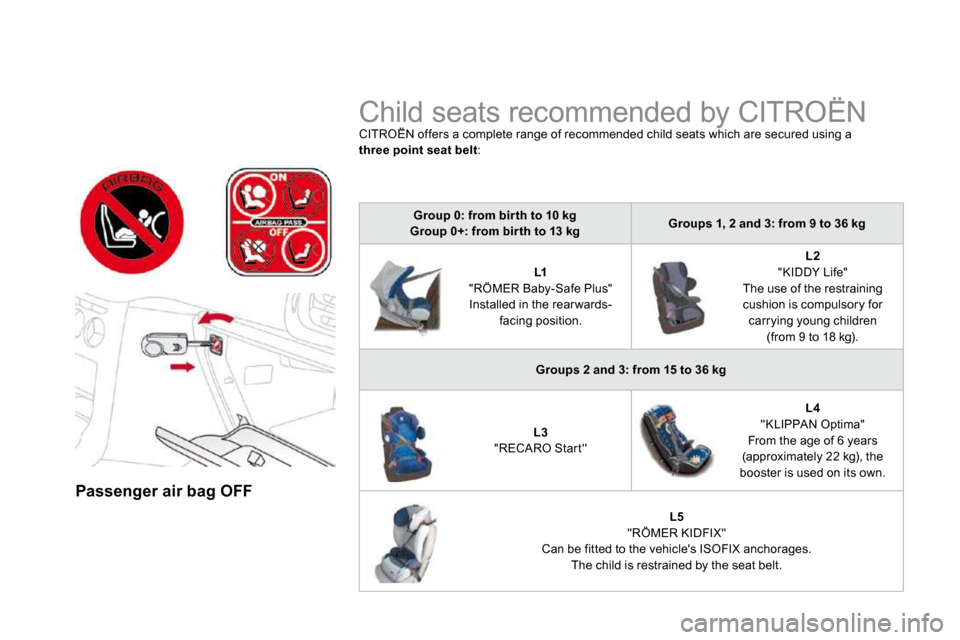
Passenger air bag OFF
Child seats recommended by CITROËN CITROËN offers a complete range of recommended child seats which are secured using a Child seats recommended by CITROËN Child s
three point seat belt :
Group 0: from bir th to 10 kg Group 0+: from bir th to 13 kgGroups 1, 2 and 3: from 9 to 36 kg
L1 "RÖMER Baby-Safe Plus" Installed in the rear wards-facing position.
L2 "KIDDY Life" The use of the restraining cushion is compulsory for carrying young children (from 9 to 18 kg).
Groups 2 and 3: from 15 to 36 kg
L3 "RECARO Star t''
L4 "KLIPPAN Optima" From the age of 6 years (approximately 22 kg), the booster is used on its own.
L5 "RÖMER KIDFIX" Can be fitted to the vehicle's ISOFIX anchorages. The child is restrained by the seat belt.
Page 114 of 244
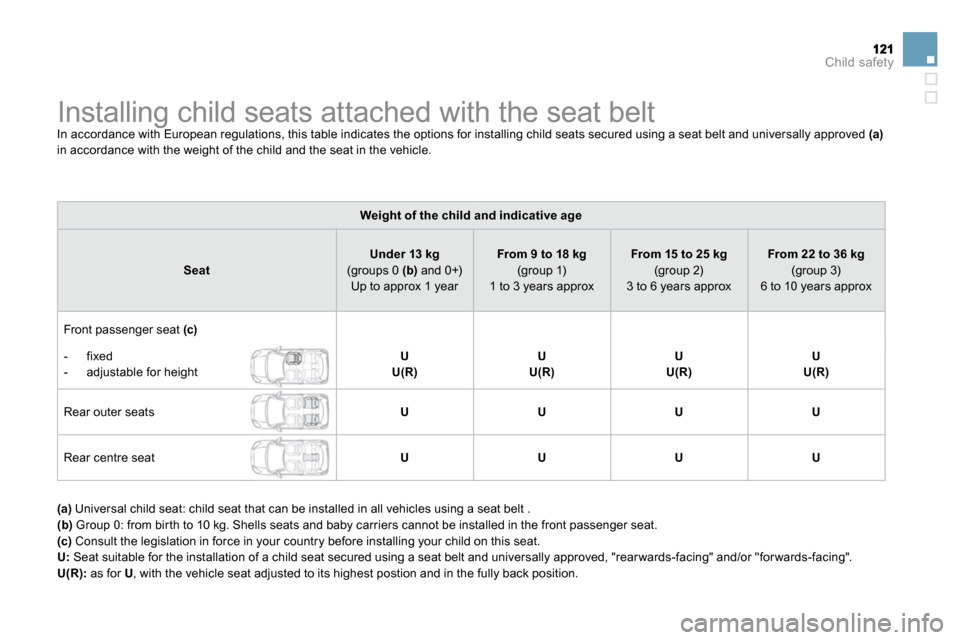
Child safety
Installing child seats attached with the seat belt In accordance with European regulations, this table indicates the options for installing child seats secur ed using a seat belt and universally approved (a)in accordance with the weight of the child and the seat in the vehicle.
Weight of the child and indicative age
SeatUnder 13 kg (groups 0 (b) and 0+) Up to approx 1 year
From 9 to 18 kg (group 1) 1 to 3 years approx
From 15 to 25 kg (group 2) 3 to 6 years approx
From 22 to 36 kg (group 3) 6 to 10 years approx
Front passenger seat (c)
- fixed - adjustable for height U U(R)U U(R)U U(R)U U(R)
Rear outer seats UUUU
Rear centre seat UUUU
(a) Universal child seat: child seat that can be installed in all vehicles using a seat belt . (b) Group 0: from bir th to 10 kg. Shells seats and baby c arriers cannot be installed in the front passenger seat. (c) Consult the legislation in force in your country before installing your child on this seat. U: Seat suitable for the installation of a child seat secured using a seat belt and universally approved, "rear wards-facing" and/or "for wards-facing". U(R): as for U , with the vehicle seat adjusted to its highest postion and in the fully back position.
Page 115 of 244
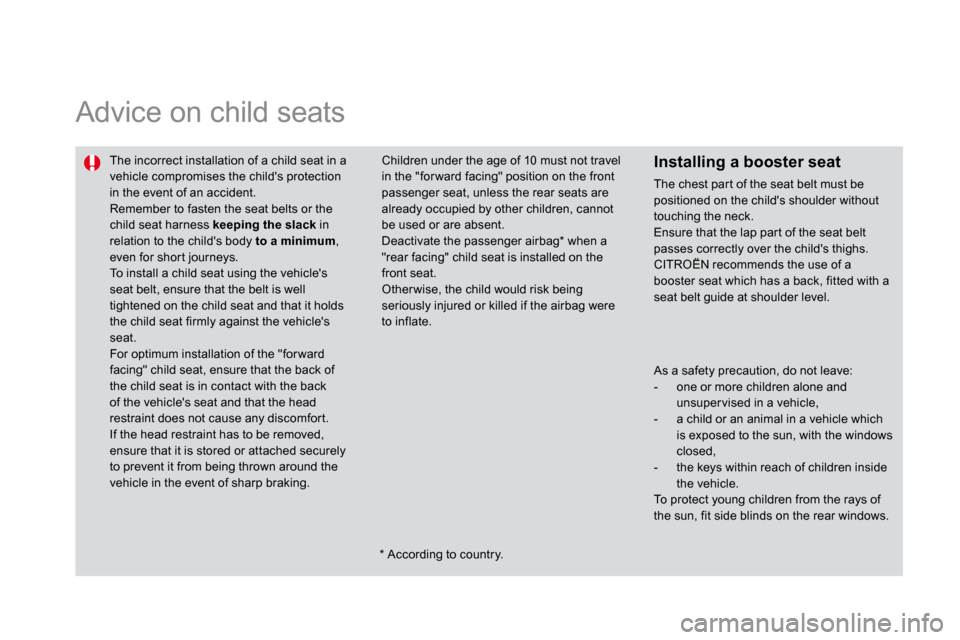
Advice on child seats
The incorrect installation of a child seat in a vehicle compromises the child's protection in the event of an accident. Remember to fasten the seat belts or the child seat harness keeping the slack in relation to the child's body to a minimum , even for shor t journeys. To install a child seat using the vehicle's seat belt, ensure that the belt is well tightened on the child seat and that it holds the child seat firmly against the vehicle's seat. For optimum installation of the "for ward facing" child seat, ensure that the back of the child seat is in contact with the back of the vehicle's seat and that the head restraint does not cause any discomfor t. If the head restraint has to be removed, ensure that it is stored or attached securely to prevent it from being thrown around the vehicle in the event of sharp braking.
Children under the age of 10 must not travel in the "for ward facing" position on the front passenger seat, unless the rear seats are already occupied by other children, cannot be used or are absent. Deactivate the passenger airbag * when a "rear facing" child seat is installed on the front seat. Other wise, the child would risk being seriously injured or killed if the airbag were to inflate.
Installing a booster seat
The chest par t of the seat belt must be positioned on the child's shoulder without touching the neck.
Ensure that the lap par t of the seat belt passes correctly over the child's thighs. CITROËN recommends the use of a booster seat which has a back, fitted with a seat belt guide at shoulder level.
* According to country.
As a safety precaution, do not leave: - one or more children alone and unsuper vised in a vehicle, - a child or an animal in a vehicle which is exposed to the sun, with the windows closed, - the keys within reach of children inside the vehicle. To protect young children from the rays of the sun, fit side blinds on the rear windows.
Page 116 of 244

123Child safety
Your vehicle has been approved in accordance with the new ISOFIX regulation . The seats, represented below, are fitted with regulation ISOFIX mountings:
"ISOFIX" mountings
There are three rings for each seat: - two rings A , located between the vehicle seat back and cushion, indicated by a label,
- a ring B , behind the seat, referred to as the TOP TETHER for fixing the upper strap.
This ISOFIX mounting system guarantees you fast, reliable and safe fitting of the child seat in your vehicle. The ISOFIX child seats are fitted with two locks which are secured easily on the two rings A .
Some also have an upper strap which is attached to ring B . To attach this strap, raise the vehicle seat's head restraint then pass the hook between its rods. Then fix the hook on ring B and tighten the upper strap.
The incorrect installation of a child seat in a vehicle compromises the child's protection in the event of an accident.
For information regarding the ISOFIX child seats which can be installed in your vehicle, consult the summary table for the location of the ISOFIX child seats.